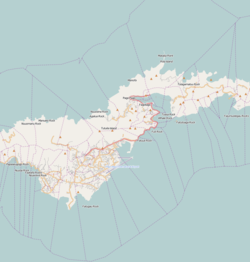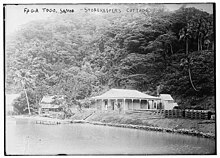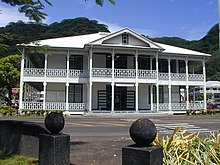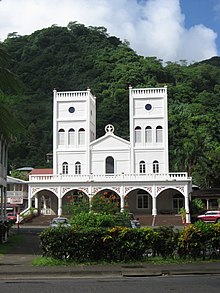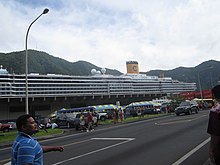
Eni Fa'aua'a Hunkin Faleomavaega Jr. was an American Samoan politician and attorney who served as the territory's third lieutenant governor, from 1985 to 1989 and non-voting delegate to the United States House of Representatives, from 1989 to 2015. As a delegate, Faleomavaega served on committees and spoke on the House floor; however, he was not permitted to vote on the final passage of any legislation. He also was the father-in-law of former professional American football fullback Fui Vakapuna.

The flag of American Samoa consists of a red-edged white triangle pointing towards the hoist charged with a bald eagle clutching a war club and fly-whisk, with dark blue upper and lower triangles. Adopted in April 1960 to replace the "Stars and Stripes" as the official flag of the territory, it has been the flag of the Territory of American Samoa since that year. The colors used epitomize the traditional colors of the United States and Samoa.

Tofilau Eti Alesana was a Samoan politician who served as the fifth prime minister of Samoa from 1982 to 1985, and again from 1988 until his resignation in 1998.
Utulei or ʻUtulei is a village in Maoputasi County, in the Eastern District of Tutuila, the main island of American Samoa. Utulei is traditionally considered to be a section of Fagatogo village, the legislative capital of American Samoa, and is located on the southwest edge of Pago Pago Harbor. Utulei is the site of many local landmarks: The A. P. Lutali Executive Office Building, which is next to the Feleti Barstow Library; paved roads that wind up to a former cablecar terminal on Solo Hill; the governor's mansion, which sits on Mauga o Alii, overlooking the entrance to Goat's Island, and the lieutenant governor's residence directly downhill from it; the Lee Auditorium, built in 1962; American Samoa's television studios, known as the Michael J. Kirwan Educational Television Center; and the Rainmaker Hotel. Utulei Terminal offers views of Rainmaker Mountain.
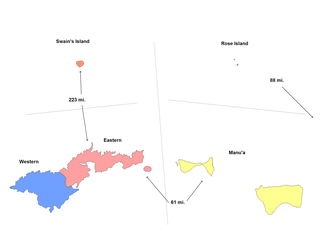
The Eastern District is one of the primary districts of American Samoa. It consists of the eastern portion of Tutuila, American Samoa's largest island, plus the island of Aunu'u. The district has a land area of 67.027 km2 (25.879 sq mi) and a 2010 census population of 23,030. It contains 34 villages plus a portion of Nuʻuuli village. Among these are Pago Pago, Fagatogo, and Utulei.
Aūa is a village on Tutuila Island in American Samoa. It is located along American Samoa Highway 001, and is the southern terminus of American Samoa Highway 006. Aūa is located at the foothills of Mount Peiva on the eastern shore of Pago Pago Bay. The hamlet of Leloaloa is also a part of Aūa.
The Constitution of American Samoa is the constitution that defines the government of American Samoa. Unlike constitutions of a state, it is subject to unilateral change by the federal government. Constitutional documents of the territory include the treaties that created it and the 1960 constitution approved by the federal government and popular referendum.
Edmund Beardsley Underwood was a Commodore in the United States Navy. Born in March 1853, at Humboldt Bay, in California, he was the son of U.S. Army Lieutenant Edmund Underwood and Mary Moore Beardsley. He graduated from the United States Naval Academy in 1873. He was Commandant of American Samoa from May 5, 1903 to January 30, 1905. He retired in 1910.

Leone is the second-largest city on Tutuila Island's west coast. The village is on the south-west coast of Tutuila Island, American Samoa. Leone was the ancient capital of Tutuila Island. Leone was also where the Samoan Islands’ first missionary, John Williams, visited on October 18, 1832. A monument in honor of Williams has been erected in front of Zion Church. Its large church was the first to be built in American Samoa. It has three towers, a carved ceiling and stained glass. Until steamships were invented, Leone was the preferred anchorage of sailing ships which did not risk entering Pago Pago Harbor. Much early contact between Samoans and Europeans took place in Leone. In the early 20th century, Leone was one of the centers for the Mau movement in American Sāmoa.
John Fredrick Parker was a Captain in the United States Navy and one-time Governor of American Samoa from May 21, 1908 to Nov. 10, 1910. John F. Parker was born in Ohio in 1853. He graduated from Annapolis in 1874 and married Elizabeth Scott Lord, niece of President Benjamin Harrison. He served as governor of Samoa from May 21, 1908 - November 10, 1910. He was stationed in Manila during the Spanish–American War. During President Benjamin Harrison's term he served as an aid. He died of Bright's disease at his home December 12, 1911.
Atuʻu is a village on Tutuila Island, American Samoa. It is located on the coast of Pago Pago Harbor, close to the capital, Pago Pago.
Laurence Wild was a United States Navy Captain, college basketball player and coach, and the governor of American Samoa from August 8, 1940, to June 5, 1942. Wild was born in Wilber, Nebraska, and lived in the 4th Congressional District of Nebraska for much of his adult life. He graduated from the United States Naval Academy in 1913; while there he played for the Navy Midshipmen basketball team, and was named a 1913 NCAA Basketball All-American. He returned as head coach of the team for one year (1913–14), coaching for ten games and winning all of them.
Lealaialoa Fredrickus Michael Kruse is the Chief Justice of the High Court of American Samoa. Kruse made history as the first person of Samoan descent to be appointed Chief Justice of the High Court of American Samoa. Kruse earned his AB degree from Victoria University in Wellington, New Zealand, and later obtained an MCL degree from George Washington University Law School in Washington, DC. He practiced law for 11 years at the firm of Kruse, Sunia, and Ward in Pago Pago before being appointed Chief Justice by U.S. Secretary of the Interior, Donald Hodel. In January 2009, Kruse was chosen to serve as Secretary of the Pacific Judicial Council, a group comprising judges and justices from across the Pacific region.
The Samoa News is a newspaper published in Pago Pago, American Samoa.

The Jean P. Haydon Museum is a museum in Pago Pago dedicated to the culture and history of the United States territory of American Samoa. It contains a collection of canoes, coconut-shell combs, pigs’ tusk armlets and native pharmacopoeia. It also houses exhibits on natural history, tapa making, traditional tattooing, as well as a collection of war clubs, kava bowls, and historic photographs. Constructed in 1913 as U.S. Naval Station Tutuila Commissary, the building was home to Tutuila Island's Post Office from 1950 to 1971. The museum has displays of various aspects of the Samoan Islands’ culture and history. It is the official repository for collections of artifacts for American Samoa. Funded by the American Samoa Council on Arts, Culture and the Humanities, it is the venue used for numerous of the cultural resource activities in American Samoa.

Maʻopūtasi County is located in the Eastern District of Tutuila Island in American Samoa. Maʻopūtasi County comprises the capital of Pago Pago and its harbor, as well as surrounding villages. It was home to 11,695 residents as of 2000. Maʻopūtasi County is 6.69 square miles (17.3 km2) The county has a 7.42-mile (11.94 km) shoreline which includes Pago Pago Bay.
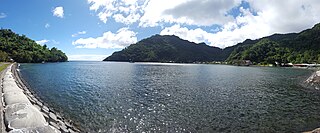
Fagasā is a village in the Eastern District of Tutuila Island in American Samoa. The village lies by Fagasa Bay, on the north shore of the island. Its name is Samoan and translates to "Forbidden Bay." The village borders the Tutuila-section of National Park of American Samoa.
Malaloa is a sub-village of Fagatogo and is located at the end of Pago Pago Harbor in American Samoa. It is located in-between Fagatogo proper and the village of Pago Pago. Cruising boats entering and leaving Pago Pago should clear at Malaloa Marina. The Malaloa Marina was opened for cruisers’ use and has added a customs wharf to handle inbound and outbound clearances.
Mauga Moi Moi (1852–1935) was a statesman and paramount Aliʻi, the highest ranking chief of Pago Pago, and signatory of the Deed of Cession. In 1920, he initiated the Mau movement in 1920 and in 1900, he signed the Deed of Cession and became a District Governor under the new U.S. naval station. He was the High Chief of Pago Pago from 1900 to 1934 and therefore also the District Governor of the Eastern District according to U.S. Naval rule.
Arthur A. Greene was an American lawyer, journalist, and Democratic Party politician. He served as Secretary of the Territory of Hawaii under Governor Joseph Poindexter and as editor for both the Honolulu Star-Bulletin and the The Honolulu Advertiser. In the early 1920s, Greene was the attorney for the Mau movement in American Sāmoa, for which he was imprisoned and deported from the territory.

